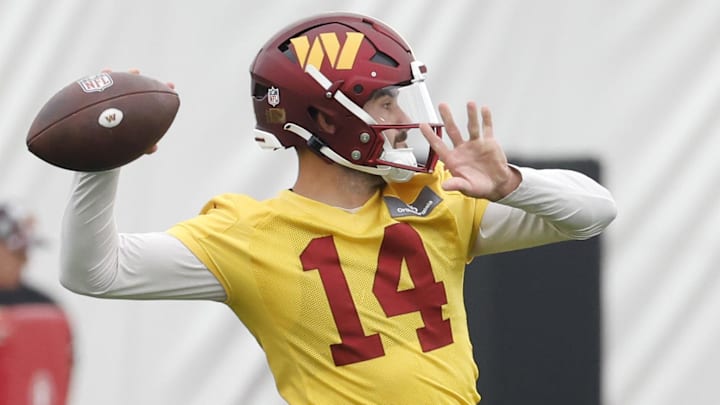What key statistic could define Washington Commanders quarterback Sam Howell's pivotal 2023 campaign as the team's No. 1 option?
This is a story about one relatively obscure way to judge Washington Commanders' presumed starting quarterback Sam Howell this season. But I’m beginning with two lists.
Consider the following two groups of quarterbacks:
LIST 1: Aaron Rodgers, Jacoby Brissett, Patrick Mahomes, Tyrod Taylor, Tom Brady, Colin Kaepernick, Justin Herbert, Russell Wilson, Daniel Jones, and Dak Prescott.
LIST 2: Payton Manning, Dan Marino, Doug Williams, Mark Rypien, Drew Brees, Patrick Mahomes, Steve Bono, Tom Brady, Derek Anderson, and John Brodie.
Which list is better?
I suppose you could quibble, but I’m going with the second list. It has more can’t-miss Pro Football Hall of Famers. Amongst its non-elite quarterbacks, it has a couple of Super Bowls (Williams and Rypien) and an NFL MVP (Brodie).
Career backups Anderson and Bono are canceled out by Brissett and Taylor. It doesn’t have Rodgers, but LIST 1 doesn’t have Manning or Brees. It’s close, but the edge goes to LIST 2.
LIST 1 has the top ten career leaders in interception percentage. That basically means it has the quarterbacks who have been least likely to throw picks. That’s undeniably important. Everybody agrees on that.
LIST2 has the top ten career leaders in sack percentage. That means these are the quarterbacks least likely to be sacked. I’m going to argue that for a young quarterback like Howell, that is actually a more important gauge of how good he might become. I’ve never heard anyone make that argument before.
Your first reaction might be to discount sack percentage because it is often seen as a function of the offensive line. There’s some truth to that. But every single quarterback statistic is dependent on factors beyond their play.
Total yards, the traditional measure of a quarterback, is dependent on the scheme (how often does the team throw?) and situation (bad teams with average quarterbacks may rack up yards because they are often playing from behind against softer “prevent” defenses).
A quarterback's completion percentage is also scheme-dependent. Those operating in quick rhythm offenses may complete more short passes. I prefer yards-per-attempt as a balance to this, but even there, it can be highly influenced by personnel.
If I’m throwing swing passes to Christian McCaffrey and you’re throwing them to Kenyon Drake, I’m going to have a higher yards-per-attempt even though we may be equal quarterbacks.
Touchdown-to-interception ratio is very popular these days, but even that can be skewed by scheme and personnel. Jalen Hurts had an excellent ratio in 2022, but he still finished behind Jared Goff and Jimmy Garappolo because he ran for 13 touchdowns.
And ultimately, no single stat can ever capture how good or bad a quarterback is if it doesn’t take the situation into account. An interception on a Hail Mary at the end of the first half is negligible. An interception in the fourth quarter of a close game is devastating. Yet most statistical analyses treat them the same.
Yards accumulated in the fourth quarter of a blowout may inflate how a quarterback looks on paper. In the stats game, we call this the KCIF –Kirk Cousins Inflation Factor. Something the Commanders know all about before he left for the Minnesota Vikings.
